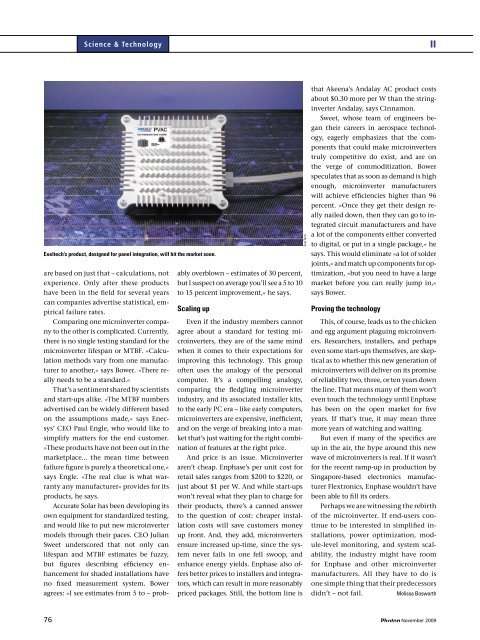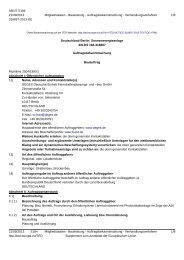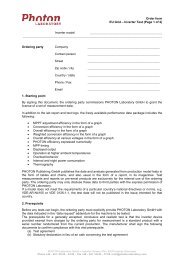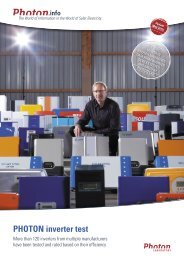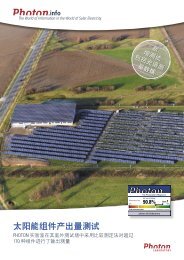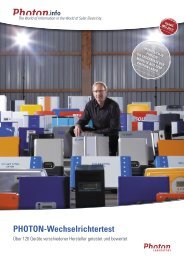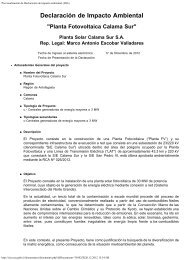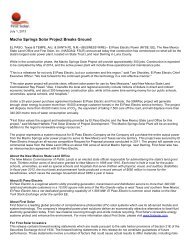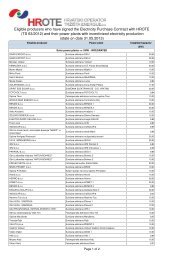INTRODUCTORY SPECIAL INTRODUCTORY ... - PHOTON Info
INTRODUCTORY SPECIAL INTRODUCTORY ... - PHOTON Info
INTRODUCTORY SPECIAL INTRODUCTORY ... - PHOTON Info
Create successful ePaper yourself
Turn your PDF publications into a flip-book with our unique Google optimized e-Paper software.
76<br />
Science & Technology<br />
Exeltech’s product, designed for panel integration, will hit the market soon.<br />
are based on just that – calculations, not<br />
experience. Only after these products<br />
have been in the fi eld for several years<br />
can companies advertise statistical, empirical<br />
failure rates.<br />
Comparing one microinverter company<br />
to the other is complicated. Currently,<br />
there is no single testing standard for the<br />
microinverter lifespan or MTBF. »Calculation<br />
methods vary from one manufacturer<br />
to another,« says Bower. »There really<br />
needs to be a standard.«<br />
That’s a sentiment shared by scientists<br />
and start-ups alike. »The MTBF numbers<br />
advertised can be widely different based<br />
on the assumptions made,« says Enecsys’<br />
CEO Paul Engle, who would like to<br />
simplify matters for the end customer.<br />
»These products have not been out in the<br />
marketplace... the mean time between<br />
failure fi gure is purely a theoretical one,«<br />
says Engle. »The real clue is what warranty<br />
any manufacturer« provides for its<br />
products, he says.<br />
Accurate Solar has been developing its<br />
own equipment for standardized testing,<br />
and would like to put new microinverter<br />
models through their paces. CEO Julian<br />
Sweet underscored that not only can<br />
lifespan and MTBF estimates be fuzzy,<br />
but fi gures describing effi ciency enhancement<br />
for shaded installations have<br />
no fi xed measurement system. Bower<br />
agrees: »I see estimates from 5 to – prob-<br />
ably overblown – estimates of 30 percent,<br />
but I suspect on average you’ll see a 5 to 10<br />
to 15 percent improvement,« he says.<br />
Scaling up<br />
Even if the industry members cannot<br />
agree about a standard for testing microinverters,<br />
they are of the same mind<br />
when it comes to their expectations for<br />
improving this technology. This group<br />
often uses the analogy of the personal<br />
computer. It’s a compelling analogy,<br />
comparing the fl edgling microinverter<br />
industry, and its associated installer kits,<br />
to the early PC era – like early computers,<br />
microinverters are expensive, ineffi cient,<br />
and on the verge of breaking into a market<br />
that’s just waiting for the right combination<br />
of features at the right price.<br />
And price is an issue. Microinverter<br />
aren’t cheap. Enphase’s per unit cost for<br />
retail sales ranges from $200 to $220, or<br />
just about $1 per W. And while start-ups<br />
won’t reveal what they plan to charge for<br />
their products, there’s a canned answer<br />
to the question of cost: cheaper installation<br />
costs will save customers money<br />
up front. And, they add, microinverters<br />
ensure increased up-time, since the system<br />
never fails in one fell swoop, and<br />
enhance energy yields. Enphase also offers<br />
better prices to installers and integrators,<br />
which can result in more reasonably<br />
priced packages. Still, the bottom line is<br />
ExelTech<br />
ıı<br />
that Akeena’s Andalay AC product costs<br />
about $0.30 more per W than the stringinverter<br />
Andalay, says Cinnamon.<br />
Sweet, whose team of engineers began<br />
their careers in aerospace technology,<br />
eagerly emphasizes that the components<br />
that could make microinverters<br />
truly competitive do exist, and are on<br />
the verge of commoditization. Bower<br />
speculates that as soon as demand is high<br />
enough, microinverter manufacturers<br />
will achieve effi ciencies higher than 96<br />
percent. »Once they get their design really<br />
nailed down, then they can go to integrated<br />
circuit manufacturers and have<br />
a lot of the components either converted<br />
to digital, or put in a single package,« he<br />
says. This would eliminate »a lot of solder<br />
joints,« and match up components for optimization,<br />
»but you need to have a large<br />
market before you can really jump in,«<br />
says Bower.<br />
Proving the technology<br />
This, of course, leads us to the chicken<br />
and egg argument plaguing microinverters.<br />
Researchers, installers, and perhaps<br />
even some start-ups themselves, are skeptical<br />
as to whether this new generation of<br />
microinverters will deliver on its promise<br />
of reliability two, three, or ten years down<br />
the line. That means many of them won’t<br />
even touch the technology until Enphase<br />
has been on the open market for fi ve<br />
years. If that’s true, it may mean three<br />
more years of watching and waiting.<br />
But even if many of the specifi cs are<br />
up in the air, the hype around this new<br />
wave of microinverters is real. If it wasn’t<br />
for the recent ramp-up in production by<br />
Singapore-based electronics manufacturer<br />
Flextronics, Enphase wouldn’t have<br />
been able to fi ll its orders.<br />
Perhaps we are witnessing the rebirth<br />
of the microinverter. If end-users continue<br />
to be interested in simplifi ed installations,<br />
power optimization, module-level<br />
monitoring, and system scalability,<br />
the industry might have room<br />
for Enphase and other microinverter<br />
manufacturers. All they have to do is<br />
one simple thing that their predecessors<br />
didn’t – not fail. Melissa Bosworth<br />
November 2009


